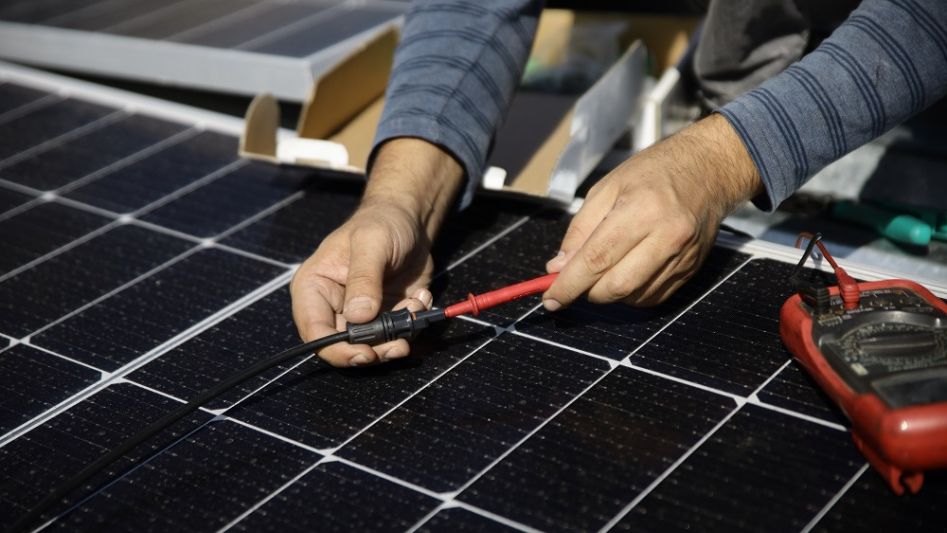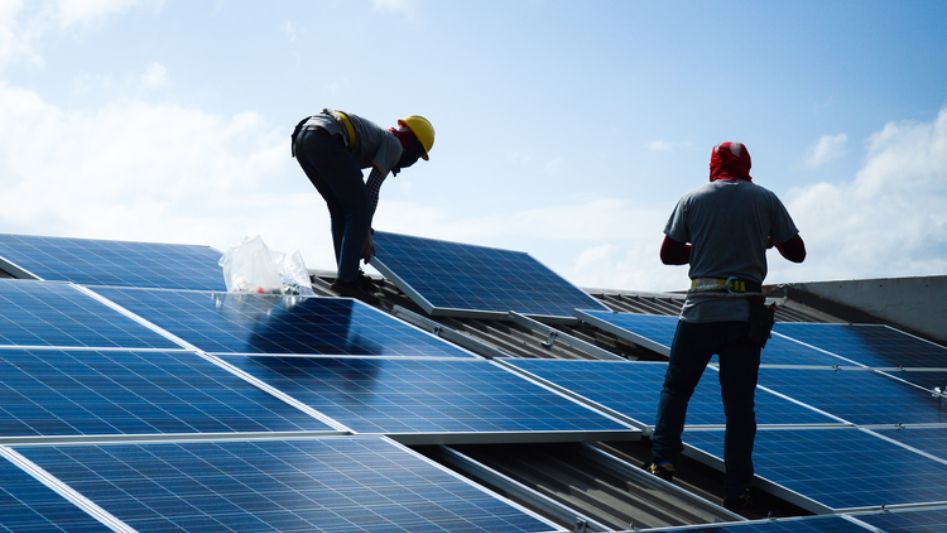The carbon footprint of a solar panel is measured in two ways: the carbon emitted during production and when the solar panels are used in homes.
Table Of Content
- Content
- Calculating Carbon Footprint
- Mining Materials
- Types of Solar Panels
- Manufacturing and Transportation
- Lifespan of a Panel
- Solar Panels vs. Standard Electricity
- How Much Better Is Solar for the Environment?
- Conclusion
- FAQ
- You May Also Like
- External Links

Solar panels have a reputation for being clean and environmentally friendly, but how precisely green are they?
Even though solar panels produce some carbon emissions over the course of their lifetime, when compared to those produced by other forms of renewable energy, the amount of carbon emissions produced by solar panels is still a negligible fraction of the amount produced by fossil fuels such as coal and natural gas. This part looks at how solar panels affect the atmosphere in terms of how much carbon they release into the air.
Calculating Carbon Footprint
Solar panels, in contrast to fossil fuels, do not produce emissions during the process of generating energy. This is one reason why solar panels are such an important part of the transition to clean energy that is happening right now to lower greenhouse gas emissions and slow climate change.
However, the industrial processes that lead up to the creation of solar energy do result in emissions. These emissions come from the mining of metals and rare earth minerals; the process of producing solar panels; and the transportation of raw materials and completed panels. It is therefore necessary to take into consideration a number of different factors when determining the net carbon footprint that solar panels have. These factors include how the materials that are used to produce the panels are obtained; how the panels themselves are manufactured; and the expected lifespan of the panel.
Mining Materials
Silicon is a chemical element that is used in the production of chips, as well as in the construction materials and industrial sectors. Platinum, in its natural state, for use in industry.
The solar cell is the fundamental element of a photovoltaic (PV) module, and it is typically constructed out of silicon semiconductors. Solar cells are responsible for absorbing the heat from the sun and converting it into useful energy. Solar cells are made up of positive and negative layers of silicon, and they work by absorbing light from the sun and then transferring electrons between the positive and negative layers of the solar cell in order to generate an electric current. A solar panel’s conductive metal grid lines carry this current as they go across the panel. In order to ensure that the solar panels are able to absorb the most possible light, each solar cell has been coated in a material that resists reflection.
In addition to silicon, solar panels make use of other rare earth and valuable metals such as silver, copper, indium, tellurium, and lithium (the latter of which is used for the storage of solar energy in batteries). The extraction of any of these materials results in the production of greenhouse gas emissions and may pollute the air, land, or water.
It is difficult to quantify these emissions because there is a lack of consistency in the measurement and reporting of the carbon footprint connected to the mining, processing, and shipping of essential metals and minerals. This makes it difficult to get accurate numbers. The Coalition on Materials Research Transparency is an organization that was established by a consortium of research institutes in an effort to find a solution to this problem by defining industry-wide standards for analyzing carbon emissions from mining. However, as of right now, that project is still in its preliminary phases.
Types of Solar Panels
There is more than one kind of solar panel, and these panels all leave behind various amounts of carbon dioxide in their wake. Monocrystalline and polycrystalline solar panels, both of which are constructed of silicon cells but are manufactured in distinct ways, are the two kinds of commercial solar panels available today. The Department of Energy reports that the energy conversion efficiency of these solar modules ranges anywhere from 18% to 22%.
A single piece of silicon is used to create monocrystalline cells, which are then sliced into wafers of varying sizes before being mounted to the screen. These are the most common, and they also have the greatest level of effectiveness. The production of single silicon crystals is a difficult procedure, and as a result, the resulting crystals create the highest levels of emissions. The production of polycrystalline solar cells, on the other hand, consumes less energy and, as a result, results in fewer emissions. This is accomplished by fusing silicon crystals together.
The third kind of solar technology is called thin-film solar, and it may produce power using a variety of different materials. Some of these materials include cadmium telluride, a form of silicon, and copper indium gallium selenide (CIGS). But thin-film panels haven’t yet reached the same level of efficiency as their counterparts made of crystalline silicon.
Solar technologies under development aim to boost the efficiency of solar photovoltaics (PV) even more. A substance known as perovskite is at the center of one of the most exciting new photovoltaic (PV) solar technologies now in the research and development stage. Perovskite crystals have a structure that is particularly efficient at collecting sunlight. In fact, it is more efficient than silicon at capturing solar radiation, whether it is inside or when there is cloud cover. Perovskite may be used to make thin films, which can then be used to make panels with increased adaptability and efficiency. These panels can even be painted onto buildings and other surfaces.
Most crucially, there is a possibility that perovskites may be produced at a far lower cost than silicon, while also using a much lower amount of energy.
Manufacturing and Transportation
However, at the moment, the most commonly used panels are those made of silicon crystalline: They were responsible for around 97% of the solar photovoltaic (PV) market in the United States in 2017, as well as the great majority of the market worldwide. However, the production of silicon panels results in significant pollutants being released into the atmosphere. Even though silicon is readily available, it must first be molten in an electric furnace at temperatures much beyond 1,000 degrees Fahrenheit before it can be put on the panel. This procedure often makes use of energy derived from fossil fuels, most notably coal.

It is a common misconception that the creation of solar panels does not significantly cut carbon emissions since fossil fuels are used in the silicon manufacturing process. However, this is not the case. Even though the construction of solar panels requires a significant amount of energy, the silicon component of the process results in emissions that are in no way comparable to those generated by energy sources that rely on fossil fuels.
Another factor to take into account is the country or countries in which solar panels are manufactured. The manufacturing of silicon panels in China has seen significant expansion during the last twenty years. In China, about half of the energy required for that process currently comes from coal; this is a far higher percentage than in Europe or the United States. Because of this, concerns have been raised over the emissions that are related to PV panels as production continues to concentrate more and more in China.
Emissions produced by modes of transportation constitute still another obstacle. Raw materials are often taken from a long way away from the production facilities, which may be on another continent or across an ocean from where the installation is.
Due to China’s increased carbon footprint from the energy sources utilized in production as well as the emissions footprint involved with transporting completed solar panels such a long distance, a silicon solar panel that was created in China and put in Europe would have twice the carbon footprint compared to one that was both manufactured and installed in Europe, according to research that was conducted in 2014 by the Argonne National Laboratory and Northwestern University.
But analysts believe that if China implements more rigorous environmental laws as part of its emissions reduction goals, the emissions gap between China and other major industrial locations might gradually reduce over time. There is also an effort being made to broaden the photovoltaic supply chain and increase manufacturing locally in the United States, the European Union, and other places. This would result in less dependence on China.
Lifespan of a Panel
Another significant aspect that goes into calculating a solar panel’s overall carbon footprint is its expected lifetime. The solar industry often promises that panels will last between 25 and 30 years, but the energy payback period—the time it takes for a panel to pay back its “carbon debt” from emissions caused during extraction, manufacture, and transport—is generally between one and three years, depending on variables such as location and the quantity of sunshine it gets. This means that after the first, usually short payback period, a solar panel can often keep giving off clean energy for decades.
Even while the efficiency of older solar panels will surely decrease with time, these panels may still provide a considerable quantity of electricity for many years beyond the expiration of their guarantee. Research that was conducted in 2012 by the National Renewable Energy Laboratory discovered that the energy production rate of a solar panel normally decreases by no more than 0.5% per year.
After figuring out the carbon footprint of a solar panel over its whole life, it is important to consider not only how the panel is thrown away when it is no longer useful, but also if any solar panels are taken down before their time.
Research that was conducted in Australia not too long ago came to the conclusion that the second scenario is more common than the first, with numerous incentives to replace panels before they reach the end of their useful life. The authors mention a combination of government incentives that stimulate the installation of newer panels and a propensity for solar businesses to cope with a broken panel by simply replacing the complete PV system when they do business as a reason for this trend. In addition, customers often decide after just a few years of usage that they want to upgrade their systems to ones that are newer, more efficient, and provide larger amounts of money saved on energy. Because of this, there is an alarming rise in the amount of electronic waste made in Australia because of solar panels that have been left behind.
When used panels have to be carried great distances to recycling facilities, recycling may provide a partial solution to the issue of disposal. Nevertheless, this may have the effect of increasing the carbon footprint. The findings of this research led the authors to the conclusion that increasing the lifespan of solar panels is critical to addressing the emissions and waste issues that are related to the disposal of end-of-life panels.
Solar Panels vs. Standard Electricity
Even though it can’t be argued that solar panels don’t leave a carbon footprint, this imprint is much smaller than the carbon dioxide emissions and other environmental problems caused by fossil fuels.
According to the findings of a study that was conducted in 2017 and published in Nature Energy, life cycle assessments of renewable and non-renewable energy sources were conducted, and it was discovered that solar, wind, and nuclear energy all have carbon footprints that are many times lower than energy that is generated using fossil fuels. Even after taking into consideration “hidden” emissions sources such as resource extraction, transportation, and production—all of which, of course, are also related to fossil fuels—this was still the case. Even with technology to collect and store carbon dioxide (CCS), the research shows that coal still puts out 18 times as much carbon as solar over its lifetime, while natural gas puts out 13 times as much as solar.
Over time, the process of making solar panels has become more efficient, and research and development work is always being done to improve efficiency while lowering costs and pollution.
How Much Better Is Solar for the Environment?
When evaluating the effects of solar panels on the environment, carbon emissions are simply one of many important factors to consider. Solar power may not contribute to environmental pollution during its production, but the solar industry is heavily dependent on nonrenewable resources like metals and minerals. This entails polluting mining activities and frequently leads to the loss of habitat and biodiversity as a consequence of mines and highways being created through pristine regions in order to enable the transfer of equipment and raw materials.
People who live in close proximity to mining activities or panel manufacturing plants that burn fossil fuels, for example, will be more likely to face negative effects as a result of using fossil fuels as a source of energy, just as is the case with any other kind of energy production. In addition, there are extra problems related to the e-waste that results from panels that have been discarded.
However, when we compare the entire effect that solar panels have on the environment to the impact that electricity produced from fossil fuel sources has, there is no contest: solar has a far less significant impact in terms of the amount of carbon emissions and pollution that it causes. But as the world moves toward low-carbon energy sources, it will be important to keep and improve rules and practices that try to reduce bad effects and more fairly share the environmental responsibilities that will come up.
Conclusion
Solar panels have a 20-year lifespan, produce electricity for 20 years, and reduce carbon dioxide emissions by 90%.Think about the potential benefits of solar energy and how it may change your life. In addition to this, the expected lifespan of solar panels is at least 25 years, which is supported by the fact that RevoluSun insures systems for a whole 25 years. The SunPower company, for example, claims that its panels will still be producing 70% of their rated power after 40 years of operation.

FAQ
How much carbon dioxide (CO2) are solar panels able to offset?
An average solar panel has a carbon payback time of around 1.6 years, since it will save more than 900 kilograms of CO2 over the course of one year.
How big of a contribution do solar panels make to the emission of greenhouse gases?
When you take into account the quantity of CO2 that is created during the manufacturing process of solar panels, you may estimate that solar panels produce around 50g of CO2 per kilowatt hour when they are first put into service. This is almost twenty times less carbon than what coal-powered energy sources give off.
Does the use of solar energy leave an imprint of carbon?
Solar power does not emit any emissions during the generating process, and life-cycle studies unequivocally reveal that it leaves a lower carbon footprint than fossil fuels do from the “cradle” all the way to the “grave.”
Are solar panels genuinely carbon neutral?
During the first few years of operation, solar panels release around 50g of CO2 for every kWh that they generate. The majority of solar panels achieve carbon neutrality by the end of the third year after installation. This is still around 20 times less carbon than what is produced by electrical sources that are fuelled by coal.
You May Also Like
- THE TRUTH ABOUT SOLAR POWERED CARS
- SOLAR OR WIND ENERGY? DO YOU KNOW WHICH ONE TO CHOOSE IN 2022?
- SUPER CONCENTRATED SOLAR POWER: THE NEW INVENTION THAT WILL CHANGE THE WORLD
- EVERYTHING YOU NEED TO KNOW ABOUT SOLAR ENERGY
- IS SOLAR ENERGY RENEWABLE OR NONRENEWABLE?
External Links
- What Is the Carbon Footprint of Solar Panel Manufacturing?
- Carbon Footprint of Solar Panel Manufacturing
- What Is the Carbon Footprint of Solar Energy? A Life-Cycle Assessment
- How Much Emissions Does a Solar Power System Prevent?
- Solar, wind and nuclear have ‘amazingly low’ carbon footprints, study finds
